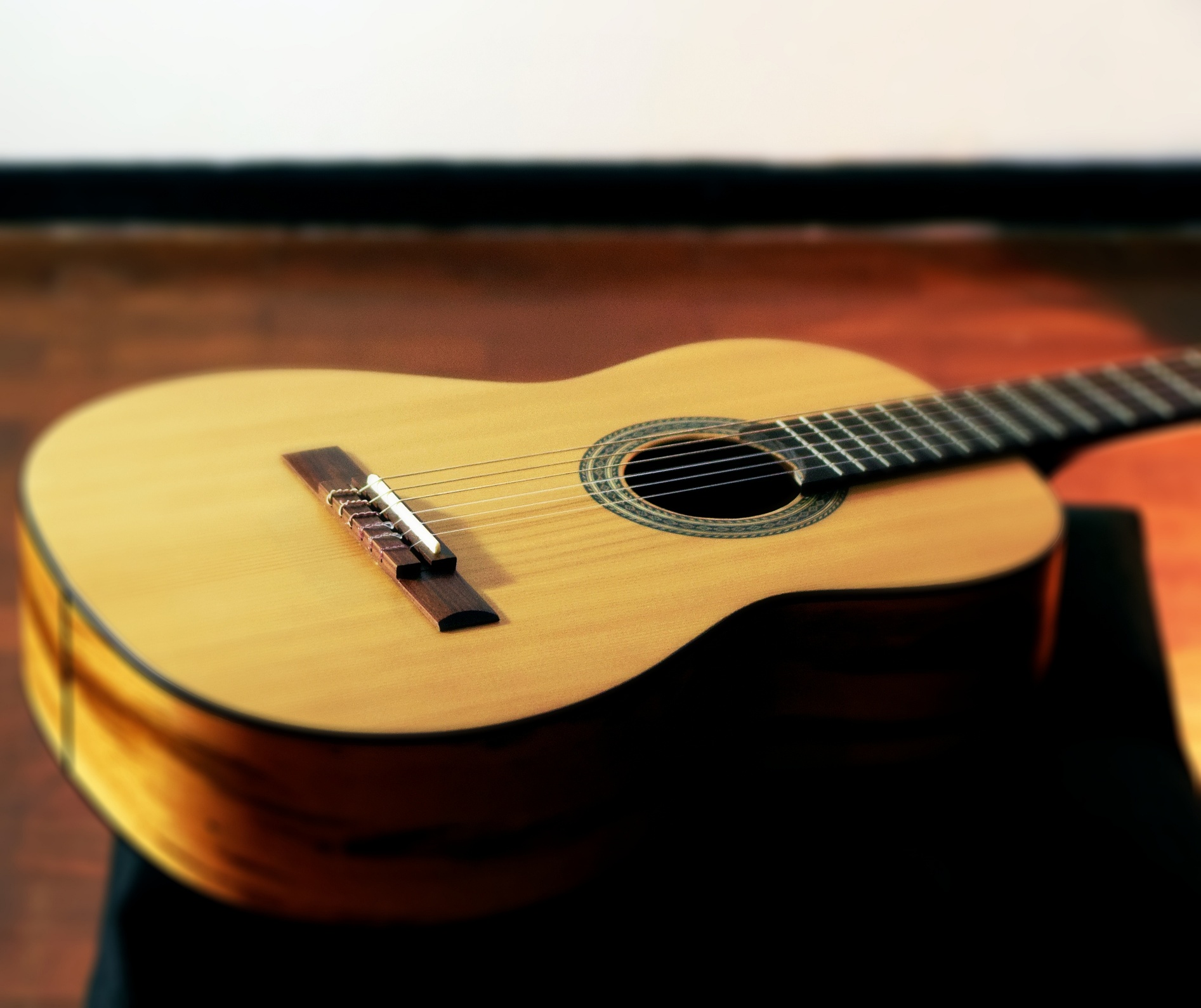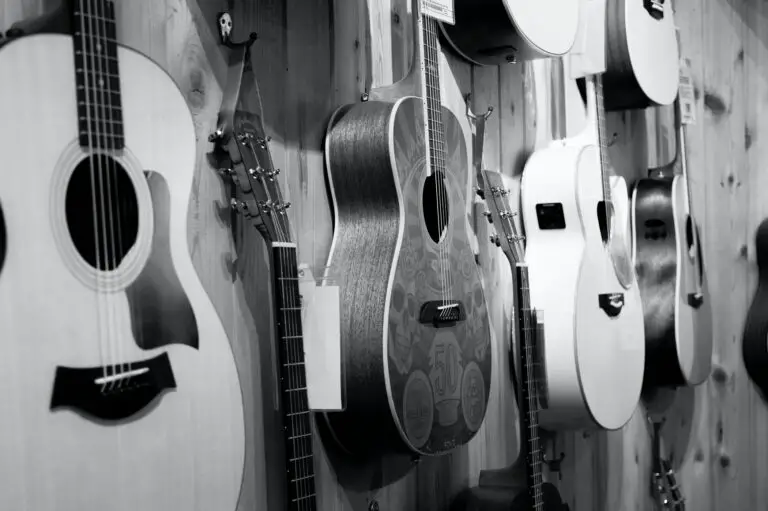Differences Between an Acoustic & an Acoustic-Electric Guitar
Acoustic guitars are one of the most popular instruments of all time. There are many guitar variants, the most popular being acoustic and electric guitars. An electric guitar is easy enough to distinguish, but what about an acoustic-electric?
An acoustic-electric guitar usually looks like an acoustic guitar. However, it also includes electronic pickups and an instrument port. Consequently, an acoustic-electric guitar can be played normally or be plugged into an amplifier.
But there’s more to it than “one has pickups and one does not.” There are unique use cases for each instrument. Read on if you’d like to learn more about their distinctions or make a more informed purchase decision.
What Makes a Guitar An Acoustic-Electric?
It isn’t rare to buy an acoustic guitar and play it for several months before discovering a strange hole that fits an instrument cable. (Side note: if it is rare, then this is embarrassing.
Ultimately, an acoustic-electric guitar looks like a regular-old acoustic model at first glance. It has a hollow wooden body and a sound hole. It uses the same kind of strings as a standard acoustic.
But unlike an acoustic guitar, you’ll see an instrument jack, a couple knobs for bass and treble, and a few wires inside the sound chamber. These things mean the guitar can be amplified like an electric guitar.
How the guitar uses these things to convert sound into electricity depends on the model. Many use magnetic pickups (like actual electric guitars), while others use microphones. The quality can vary greatly depending on the reputation of the manufacturer and, of course, how much the guitar costs.
Advantages of an Acoustic-Electric Guitar
Whether you are buying your first or seventh guitar, you should consider your use cases. An acoustic-electric guitar can undoubtedly be the right choice. However, it’s essential to understand what you’re paying for in an instrument.
In other words, an acoustic-electric guitar isn’t necessarily the best of both worlds. It can be, but that depends on how you play.
You should buy an acoustic-electric guitar if:
You prefer the sound and experience of an acoustic guitar but plan to play live
Can you use the classic acoustic guitar and mic combo to play live? Of course you can. But there are some drawbacks to this method.
For example, external mics will capture more unwanted feedback. Additionally, the sound quality will suffer due to how far the microphone sits from the acoustic sound chamber. With an acoustic-electric guitar, the built-in pickups (or mics) are in an optimal position.
With a regular acoustic, you can’t exactly shove a regular stage mic into your sound hole and get the same effect.
An acoustic-electric guitar is more convenient for live usage. Sound travels directly from the instrument resulting in a purer tone. Thus, it is easier to tweak the signal, add reverb, reduce noise, and more before it reaches the speakers.
You can only afford one guitar and would like to alternate styles
Let’s say you would like to play some soft folk music in conjunction with hard rock. Since most hard rock songs feature at least one electric guitar, you have two primary choices.
You can buy an acoustic guitar and an electric guitar. However, this can be a hard expense to justify. Thus, an acoustic-electric guitar is a logical, cost-effective middle ground.
Brands like Fender, Gibson, and Ibanez recognize that they can sell more acoustic guitars by fitting them with high-quality electronic pickups. Fortunately for us consumers, these companies have decades of experience building electric guitars.
The result is hundreds of high-quality acoustic-electric guitars for sale online. Granted, “hundreds” is probably a gross underestimation.
Budget is no issue, and you see no reason not to pay a little more just in case you need to plug in
On the flip side, the absence of a budget restriction is also a case for going with an acoustic-electric guitar. You might be able to afford both an acoustic and an electric guitar without neglecting other financial obligations.
However, if your style largely centers around playing acoustic, an electric guitar may not be suitable. Plus, if you travel a lot, why lug around two instruments if you don’t need to?
Sure, an acoustic-electric guitar might be a tad pricier than an acoustic guitar of similar quality. But spending a couple hundred dollars more for peace of mind that you can play anywhere without a hitch is totally worth it.
Advantages of a Standard Acoustic Guitar
An acoustic-electric guitar is an acoustic guitar and an electric guitar in one! How can a regular acoustic guitar possibly compete?
Believe it or not, millions of people continue to buy acoustic guitars without a single wire inside. The exception, of course, is the wires you strum.
Let’s explore why “traditional” acoustic guitars remain worth buying.
Better Sound for the Price
An acoustic guitar will probably sound better than an acoustic-electric guitar at the same price. As we mentioned, the electronics inside a guitar aren’t cheap. If they are cheap, you may not like what you hear when you plug in.
Because you aren’t paying a premium for pickups, an acoustic guitar is much more reasonably priced. If you strictly intend to play your guitar as an acoustic guitar and don’t plan on performing in loud venues, why splurge?
The money you spend on an acoustic guitar is tied to materials, acoustics, and craftsmanship. A $500 acoustic guitar is a $500 acoustic guitar. At this price, it should offer an exceptional tone and last you years.
Meanwhile, a $500 acoustic-electric guitar is like a $300 acoustic guitar plus $200 worth of electronics you may never use.
It’s straightforward
If you’re not using your guitar live, why complicate the purity of your instrument with needless wires?
Sometimes, all you need is a guitar that you can pick up and strum without needing to plug anything in. Plus, there’s something classy about a traditional acoustic guitar. It shows that it doesn’t need to rely on electronics to give it a boost.
It says, “I’m happy with the way I am.”
Acoustic-Electric Guitar Vs. Electric Guitar
What about electric guitars? How do they fit in?
Electric guitars undoubtedly influenced the creation of acoustic-electric guitars. Mister or Miss Acousticelectricguitar, the inventor of this instrument, probably said, “There are electric guitars now. There are also acoustic guitars. Why not combine them?”
In all seriousness (please do not fact-check the last paragraph), an acoustic-electric guitar is essentially a hybrid between an acoustic and an electric guitar. But it bears more resemblance to the former.
To play an electric guitar, you need an amp. Most electric guitars are solid-bodied, meaning they have no sound hole to amplify strings naturally. When you strum one unplugged, all you’ll hear is a whisper.
Advantages of an Electric Guitar
People in the market for acoustic guitars are more likely to consider acoustic-electric models than those in the market for electric guitars. Acoustic-electric guitars play like acoustics — they just have an extra feature.
Meanwhile, electric guitars are almost entirely different instruments. While they have the same notes, frets, and strings, the experience of playing an electric guitar is one-of-a-kind. This can be problematic for some and advantageous for others.
Electric guitars excel over acoustic and acoustic-electric guitars in quite a few areas. Take a look at what these “areas” are.
Size
They might not be much lighter, but electric guitars are certainly less bulky than their acoustic brethren. If you’ve attended or viewed any live performances, you’ll likely notice that electric guitarists (i.e., Angus Young) are much more mobile.
Meanwhile, acoustic guitar players tend to stay put in place in front of a mic. There are exceptions, of course, but it’s no doubt easier to hop around stage with a more compact instrument.
Acoustic guitars require big, hollow sound chambers. Larger sound chambers result in fuller volume. Unfortunately, the drawback is extra bulk.
Electric guitars rely exclusively on electronic amps. While amps and speakers can be massive, they can be placed anywhere on stage with a long enough cord. Alternatively, if you’d rather play with headphones, an amp like this one is small enough to fit in your pocket.
Durability
If you want to smash a guitar in anger, go with an acoustic. Smashing an electric guitarinto a pile of splinters takes serious strength.
Additionally, electric guitars are usually more robust. In humid conditions, acoustic guitars are more likely to warp due to their hollow-bodied build.
But this doesn’t mean that electric guitars are invulnerable to weathering and you shouldn’t take diligent care of them. That said, you’ll likely need to drop an electric guitar from a great height, set it on fire, or go swimming with it to totally destroy it.
As long as you take good care of your electric guitar, it’ll probably outlive you.
Volume
Queue the stereotypical annoyed neighbor who says, “That’s not a pro!” It’s true that, with amplification, electric guitars can get insanely loud. In fact, they are the world’s second loudest instrument.
But electric guitars can also be quieter than acoustic guitars. You can play with headphones in the same room as a sleeping person with few issues.
In other words, electric guitars have a virtually unlimited volume range. They can produce between 50 decibels (about the hum of a refrigerator) and 126 decibels (Pete Townshend’s guitar during a The Who concert).
Keep in mind that decibels aren’t linear; they’re logarithmic. Every 10 decibels represent (approximately) a doubling of volume. Thus, 100 decibels isn’t twice as loud as 50 decibels. It’s thirty-two times as loud. Furthermore, 125 decibels (the loud end of an electric guitar) is nearly two hundred times as loud as 50 decibels.
Indeed, electric guitars have quite a range. Of course, you’ll need some massive speakers to achieve anything close to that high — but your eardrums are begging you not to try.
More Tone Versatility
With an electric guitar (acoustic-electrics included), you can create any tone you want. Treble, bass, and mid tones are the most basic adjustments. Add in effects pedals, virtual amp libraries, and swapping out pickups; the versatility becomes limitless.
Changing the tone of an acoustic guitar has more limits. Beyond changing strings and strumming differently, there isn’t much you can do to alter your sound.
Easier to play
Obsessive tone-dialing aside, an electric guitar offers an easier playing experience. Strings are thinner, resulting in more effortless chord-strumming and rapid soloing. Thus, you don’t need callouses of steel to play — callouses of stone are enough.
Furthermore, you can crank the volume knob if you’re playing too softly. With a regular acoustic, you’ll need to suck it up and strum harder if you want to be louder.
What to Look For in an Acoustic-Electric Guitar
First, let’s explore what to look for in a standard acoustic guitar.
How do you tell a lousy guitar from a good one? Well, standards rise with prices. Expecting a $200 guitar to contain only genuine mahogany and Sitka spruce is a tall ask. If you’re spending over $2,000, though, high-quality lumber should be a given.
At the same time, expensive wood does not automatically mean better sound quality. Yes, genuine wood sounds … genuine. However, engineered materials have come a long way. So, if you have the money to spend on a guitar made of mahogany rather than laminate, go for it.
If not, know that you can snag a capable acoustic guitar for under a few hundred bucks. A safe bet is to go with a trustworthy brand:
Being able to hold and play the guitar before buying is ideal. Comfort and fit ensure that you enjoy playing your new instrument. If you can’t test out different models in person (or don’t want to), looking at video reviews can give you a better sense of scale.
The tone is also a significant and personal attribute. Not everyone wants their guitar to sound a certain way. For example, some people like twang and treble while others value bass. Again, testing the guitar in person is best but seeing a video is a close second.
What about acoustic-electric guitars? All of this applies to them, too. However, now you must consider pickup quality. Bear in mind that an otherwise fantastic guitar can have disappointing pickups.
Types of Pickups in an Acoustic-Electric Guitar
So far, we have used the term “pickups” to describe the mechanisms inside of an acoustic-electric guitar. Magnetic pickups are the norm in 99.9% of electric guitars. But acoustic-electric guitars don’t have such a standard.
There are several kinds of pickups that add the “electric” to acoustic guitars. All of them are considered transducers, meaning they process energy (like string vibrations) into electricity.
Most acoustic-electric guitars feature one or a combination of the following three types.
Magnetic Pickups
Magnetic pickups are identical to what standard electric guitars use. Some people call them soundhole pickups due to their wonky placement. Indeed, magnetic pickups must be placed over the soundhole to function correctly.
Their ease of installation makes magnetic pickups a popular choice. However, they aren’t without drawbacks.
Firstly, they obstruct the acoustic sound chamber. Not only do they look weird, but they can obstruct the natural flow of sound waves. While this doesn’t make a huge difference, it’s still something to consider.
Also, magnetic pickups only work with steel strings, making them unsuitable for nylon-stringed classical guitars.
Undersaddle Pickups
Most acoustic-electric guitars have under-saddle pickups (A.K.A. piezoelectric pickups). They are discrete, sensitive, and compatible with all string materials. They do not inhibit the flow of sound in and out of the guitar.
The only real downside to under-saddle pickups is installation. If you ever want to upgrade them, you’ll need to remove the bridge saddle that runs along the back of your guitar’s neck.
Microphone Pickups
This kind of pickup requires the least amount of explanation. A microphone pickup (if you can call it a pickup) is merely a microphone tucked out of sight within the instrument.
Most acoustic-electric guitar players will attest that microphone pickups sound the best. Unfortunately, they have a couple of snags that prevent them from being a go-to.
For one, they’re literal microphones. They will capture noises outside the guitar, especially in a boisterous venue. Feedback also tends to creep in. You’ll need software to eliminate the issue, which can be a pain.
Microphone pickups are also pricier than magnetic and under saddle pickups. Ultimately, mic pickups are not the best choice for most guitarists. Instead, they excel when sound quality is critical and feedback is controllable. A recording studio comes to mind.
Conclusion
An acoustic-electric guitar is an acoustic guitar that you can plug into an amp. They have instrument jacks like electric guitars but otherwise look and sound like acoustics.
But there’s more to them than that.
With acoustic-electric guitars, you aren’t restricted to playing solo. If you need to crank the volume on stage, you can easily do so. Furthermore, they can do everything acoustic guitars can — with added features.
Nevertheless, acoustic guitars are perfect for most people. They provide unbeatable value for those who don’t intend to plug in.








